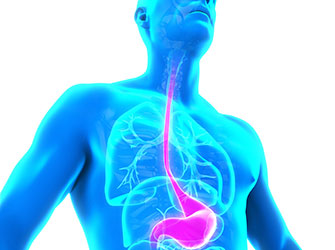Gene analysis could allow the risk determination for esophageal cancer

Gene analysis could allow the risk determination for esophageal cancer
Esophageal cancer is the eighth most common tumor disease in the western world. A subtype, the adeno carcinoma, is the kind of cancer with the strongest relative increase during the past 10 years, namely around 600% in men and up to 380% in women.
The highest risk factor for esophageal cancer is heartburn, i.e. the reflux of sour and acrid stomach liquid into the esophagus (reflux). If reflux remains untreated, it can lead to genetic changes in the mucous membrane and thus to the outbreak of the disease in the long term.
One preliminary stage of adeno carcinoma is the so-called Barrett esophagus, which also exhibits mutations in the mucous membrane. Barrett esophagus leads to esophageal cancer in 0.5% of the cases. In order to prevent a malignant development, physicians recommend the removal of this mucosal change.
Control modules for the tumor development
As not all cases of Barrett esophagus become malignant, it is important for the treating physician to know whether there are reliable indicators (so-called biomarkers) which allow the estimation of a tumor development in the still benign tissue. Sebastian Schoppmann of the University Clinic for Surgery at the MedUni Vienna and the AKH Vienna, Chief of CCC-GET and one of the managers of the study:
“In this project, we have examined the role of molecular-biological control modules for this tumor occurrence, the so-called miDNA in the affected tissue with the aid of a gene test. Our results show that the miDNA profiles of esophageal cancer are indeed different from Barrett esophagus.”
Risk estimation and cost-saving disease control
The results of the study suggest that, based on the existence of specific miDNA, it is possible to estimate whether the existing change in the mucous membrane develops into a malignant disease. It would save patients from enduring the removal of the Barrett esophagus and save costs with respect to the follow-up checks of the disease.
Top cooperation
All 300 patients who participated in the study were procured from the CCC-GET unit of MedUni Vienna and AKH Vienna. Schoppmann: “The cooperation with the National Institutes of Health and the Johns Hopkins University, both extremely renowned establishments in the USA, is a great success. The cooperation not only shows the expertise we have developed during the past years, but also that it is recognized in international circles.”
Media Contact
All latest news from the category: Life Sciences and Chemistry
Articles and reports from the Life Sciences and chemistry area deal with applied and basic research into modern biology, chemistry and human medicine.
Valuable information can be found on a range of life sciences fields including bacteriology, biochemistry, bionics, bioinformatics, biophysics, biotechnology, genetics, geobotany, human biology, marine biology, microbiology, molecular biology, cellular biology, zoology, bioinorganic chemistry, microchemistry and environmental chemistry.
Newest articles

Superradiant atoms could push the boundaries of how precisely time can be measured
Superradiant atoms can help us measure time more precisely than ever. In a new study, researchers from the University of Copenhagen present a new method for measuring the time interval,…

Ion thermoelectric conversion devices for near room temperature
The electrode sheet of the thermoelectric device consists of ionic hydrogel, which is sandwiched between the electrodes to form, and the Prussian blue on the electrode undergoes a redox reaction…

Zap Energy achieves 37-million-degree temperatures in a compact device
New publication reports record electron temperatures for a small-scale, sheared-flow-stabilized Z-pinch fusion device. In the nine decades since humans first produced fusion reactions, only a few fusion technologies have demonstrated…





















